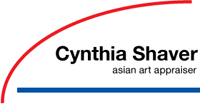The inquiry at the beginning of last month I got by email, regarded 13 antique Korean painted scrolls, that had been in the client’s family for at least two generations. The goal was to sell the paintings. I am not in business of buying and selling, but giving the information needed to client to make an informed decision. To help her achieve this goal, meant inspecting and identifying each painting, each artist, researching the sales history, and noting where, or at what auction the sales achieved were the best. My client’s father had left Korea in late 1950s and immigrated to the United States. After that point in time, he started acquiring and investing in antique Asian Art, especially while visiting China and Korea and more specifically, Korean paintings.
Our time with the client was four hours, discussing each painting, just about twenty minutes per scroll. We mentioned how many of the scrolls had condition problems, or foxing, a type of molding that happens when moisture is in the air. Titles and artists were identified, if possible, without major research, and the date of paintings was established at the beginning of the 21st century. Five of the scrolls appeared to be seasonal in title and theme, probably displayed a few months a year. Six of the paintings were probably meant for a six-panel floor screen. These six scrolls were landscape in genre, dark, with gray shadows of discoloring. The idea at the beginning of client appointment, and written into the contract, was after inspection of the scrolls, if one scroll needed extra attention, then a new contract would be written, and scope of work discussed again, anew.
Kalim discovered in research that a horizontal banner, of calligraphy and dedicated, was done by the first President of South Korea. We, appraisers and client, agreed the value in this country, would be nominally affected by this discovery. The client has selected a museum in South Korea for final donation. This exchange needs further research and what IRS financial realizations for donation to a foreign country also needs further study. A fun discovery, nevertheless.
Last month, I also attended by zoom, a fascinating symposium on The Cotsen Textile Collection,
“[re]Think Silk is an interdisciplinary, cross-cultural examination of silk and sericulture that explores the subject beyond traditional geographic and cultural perspectives.”
https://museum.gwu.edu/cotsen-textile-traces-colloquium-rethink-silk
held at the Textile Museum, George Washington University. I learned how silk was produced and marketed around the world, in wild form in parts of Africa, to highly mechanized production in 1880’s Japan. I encourage all readers to explore.

